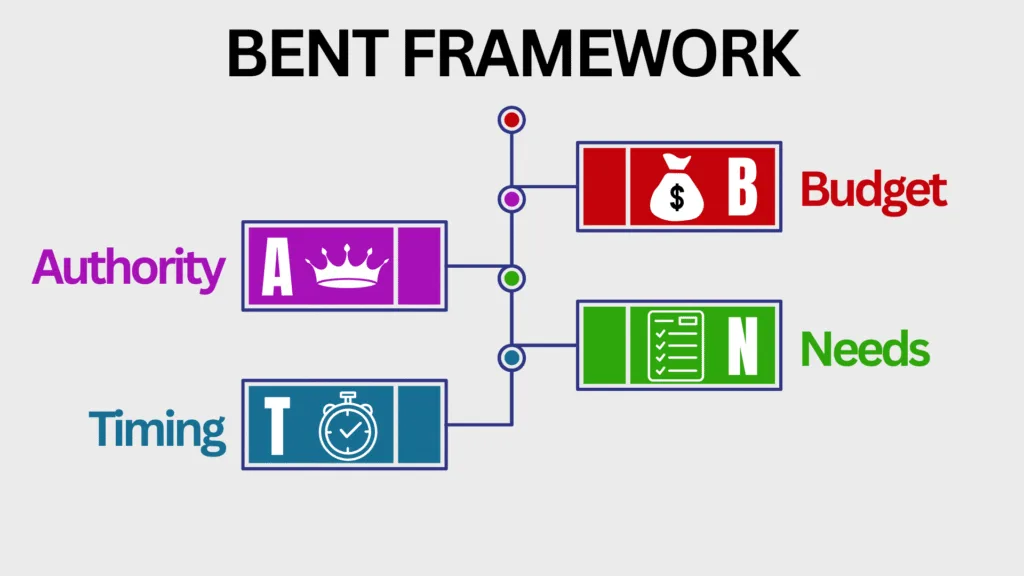If you’ve been in sales for a long, you may have heard of BANT. You could have even used it. But I have a question for you: Are you truly utilizing it correctly? Most salespeople and teams really do use the BANT sales process like a checklist. They ask the fundamental questions and then move on, never really using the full potential of this method. That’s where they go wrong. A much.
We’re going to go right into the realm of BANT sales in this post. Not the old-school, robotic technique. We’re talking about a contemporary, adaptable BANT sales method that puts people first and helps you complete transactions quicker and get more of them. Learning how to master BANT may really impact the way you sell, whether you’re new to it or have been doing it for a long time.
So strap up, because we’re going to lay down how to actually leverage the BANT sales strategy for maximum effect. No fluff. Just sensible, real-world methods.
What is BANT?
Let’s start with the fundamentals. BANT stands for:
- Budget
- Authority
- Need
- Timeline
It was first created by IBM as a framework to qualify leads. Pretty straightforward, right? You find out whether your prospect has the money, the decision-making authority, a true need, and a defined schedule. If they do, they’re a decent lead. If not, you go on.
But here’s the deal. That fundamental description hardly scrapes the surface. Used effectively, the BANT sales technique isn’t simply about qualifying leads. It’s about knowing them on a deeper level and utilizing that information to direct them toward a victory for both of you.
The Problem With How Most People Use BANT
A lot of salesmen consider BANT like a checklist during discovery calls.
“Do you have budget?”
“Are you the decision maker?”
“What’s your timeline?”
You may certainly feel it yourself – it sounds stiff and forced. The prospect feels like they’re being probed. And worst of all, you don’t create any true relationship.
This is why many salespeople feel that the BANT sales strategy is outmoded. But the reality is, it’s not BANT that’s outmoded. It’s the way people utilize it. If you approach it with curiosity instead of questioning, and discussion instead of checklists, it becomes a powerful tool that helps you learn what your consumer actually wants.
Rethinking Each Part of the BANT Sales Process
Let’s go into each aspect of BANT and look at how to use it in a manner that truly helps you close more business.
1. Budget: More Than Just a Number
Most salesmen ask, “What’s your budget?” and hope for a clear figure. But the reality? Buyers frequently don’t know their budget, or they don’t want to tell it straight away.
Instead, attempt to identify how people think about spending money. Do they regard this as an investment or a cost? Who needs to approve major purchases? Have they purchased comparable solutions before?
Better approach:
“Help me understand how your team typically makes investments like this.”
“What would success look like if you invested in a solution like ours?”
“Have you tried anything similar before? What did you spend on that?”
You’re not simply asking whether they have the money — you’re learning how they distribute it and explain it.
2. Authority: The Decision-Making Web
This one becomes difficult. People frequently question, “Are you the decision maker?” That’s not just uncomfortable, it might be offensive or deceptive. The reality is, decision-making nowadays is shared among various stakeholders.
Instead, ask questions that help you map out the complete decision-making process. Your aim is to discover who’s involved and how they operate together.
Better approach:
“Who else on your team would benefit from being part of this conversation?”
“What does your internal process look like for making decisions like this?”
“Is there anyone who typically weighs in when you’re reviewing new solutions?”
Using this method, you don’t simply discover the authority – you expose the decision dynamics. And that’s gold.
3. Need: The Heart of the Conversation
This is where excellent sellers shine. Identifying the true need isn’t only about asking, “What problem are you trying to solve?”
The greatest sales representatives explore deeper. They find pain areas the consumer may not have even voiced yet. They ask the type of meaningful questions that make the customer pause and realize, wow, no one’s asked me that before.
Better approach:
“What’s holding you back from hitting your goals this quarter?”
“What happens if this problem isn’t solved in the next few months?”
“If you had a magic wand and could fix one thing, what would it be?”
When you understand the need on an emotional and commercial level, you present yourself as a real partner – not simply another vendor.
4. Timeline: Urgency vs. Interest
Most salespeople inquire, “When are you looking to make a decision?” And again, they’ll either receive a vague response or a default “in the next few months.”
What you want to understand is the why behind their timeframe. Is there an event driving urgency? A fresh initiative? A deadline from leadership?
Better approach:
“What’s driving the timeline for this project?”
“Is there anything on the calendar that we should be aware of?”
“What happens if this isn’t implemented by [date]?”
This helps you recognize urgency, develop a better argument, and prioritize your offers more effectively.
How to Use the BANT Sales Method in a Natural Conversation
One of the major fallacies is that you have to go through BANT in sequence. You don’t.
Great talks are flexible. You could speak about Need before Authority. Or Budget can come up last. The idea is to cover all four — yet in a manner that seems natural and true.
Some representatives even integrate BANT into their CRM fields and attempt to check them off during conversations. That’s OK if it helps you keep organized. Just make sure it doesn’t take away from the human part of the interaction.
Why BANT Sales Still Works in 2025
With all the latest sales frameworks flying around — MEDDIC, SPIN, Challenger — it’s tempting to imagine BANT is old news. But here’s the truth: the basics never go out of style. And BANT is all about basics.
The fundamental strength of the BANT sales technique is its simplicity. It offers you a framework to lead discovery, qualify efficiently, and keep focused on opportunities that are genuinely worth your time.
But to make it work, you need to stop thinking of it as a shape and start utilizing it like a lens. A lens to comprehend your buyer’s world.
Common Mistakes to Avoid in the BANT Sales Process
Before we conclude up, let’s look at a few hazards that might sink even the most enthusiastic BANT users.
1. Treating it like a script
If you sound like a robot, your customer tunes out. Use BANT as a guide, not a script.
2. Rushing through the procedure
Don’t attempt to certify someone in five minutes. Real discovery takes time.
3. Not adapting to the buyer’s context
A startup buyer and a Fortune 500 buyer won’t respond questions the same way. Adapt your strategy.
4. Ignoring emotional drivers
Budget and timetable important, but passion drives urgency. Tap into it.
How to Train Your Team on the BANT Sales Technique
If you’re running a sales team, training people how to understand BANT may produce big results. But again, avoid making it into a checklist exercise. Use call records, role plays, and actual transactions to illustrate what excellent looks like.
Encourage your legislators to listen more than they speak. The purpose isn’t to acquire answers. The objective is to comprehend.
Final Thoughts: BANT is Your Secret Weapon – If You Use things Right
To sum things up, BANT is far from dead. It’s one of the most effective sales frameworks available – when you know how to use it correctly. The idea is to stop treating it as a formula and start utilizing it like a discussion map.
Focus on curiosity over control. Empathy above efficiency. Understanding over questioning.
If you accomplish that, you’ll not only complete more transactions, but you’ll establish trust, gain recommendations, and become the sort of salesman customers truly love talking to.
So take a new look at your present method. Are you only asking BANT questions? Or are you genuinely mastering the BANT sales method?


